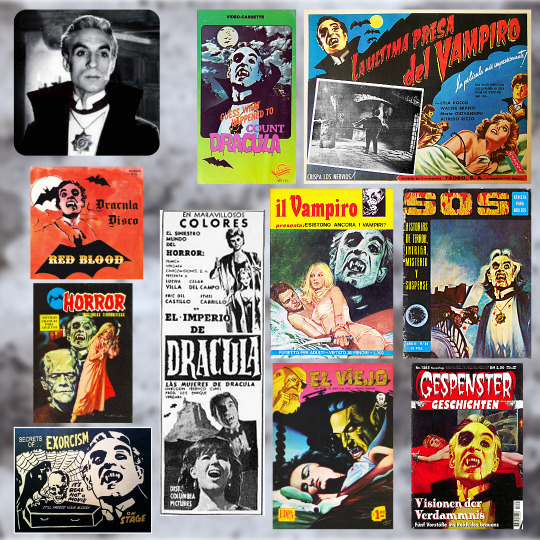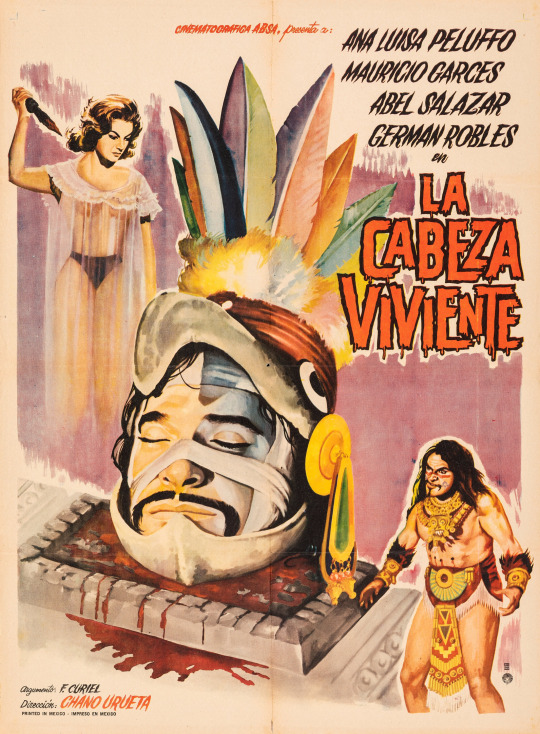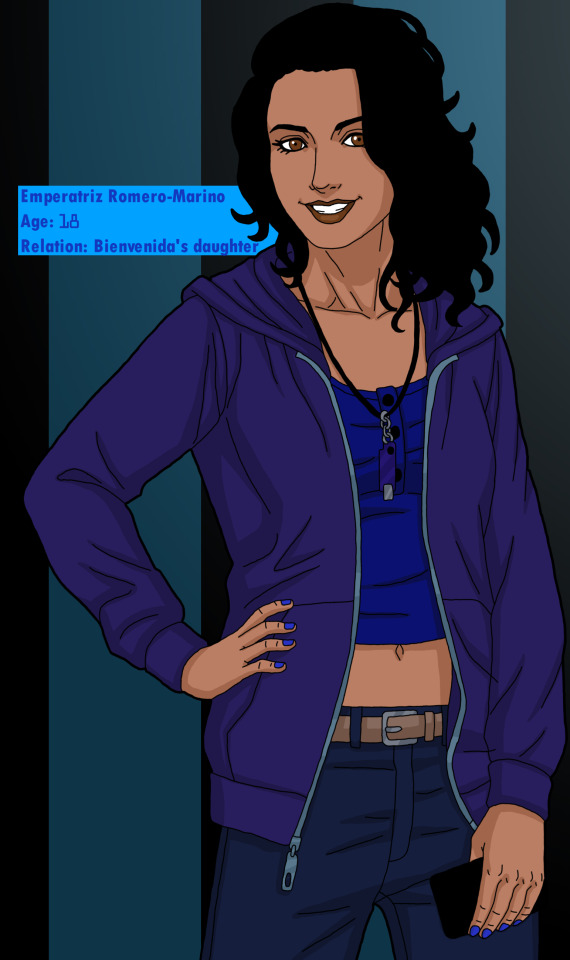#German Robles
Explore tagged Tumblr posts
Text
On January 2, 1960, El Vampiro debuted in West Germany.

Here's a new drawing of German Robles to celebrate!
#el vampiro#the vampire#el vampiro 1957#mexican film#horror film#fernando mendez#german robles#horror thriller#midnight movies#vampires#vampire art#gothic horror#gothic horror art#classic horror#1950s#1950s horror#art#movie art#drawing#movie history#pop art#modern art#pop surrealism#cult movies#portrait#cult film
2 notes
·
View notes
Text

Swipe File 26: El Vampiro Goes Viral
In honour of the upcoming Blu-ray premiere of El vampiro and El ataúd del vampiro, here are some of the many times the likeness of actor Germán Robles as "Count Duval aka Count Lavud" has been borrowed (clockwise from top left):
USA video release of a different film (Guess What Happened to Count Dracula, 1971);
Mexican lobby card for a different film (Slaughter of the Vampires, '62);
Italian fumetto Il Vampiro 44 (1978);
Spanish horror comic SOS 44 (1976);
German horror comic Gespenster Geschichten 1285 (cover by Sanjulián);
Mexico horror comic El Viejo 54 ('70, cover by García Tena);
Ad mat for a different Mexican film (El imperio de Dracula, '66, with Eric del Castillo as the vampire);
Ad for a spook show circa ’74;
Spanish horror comic Horror 10 ('74, cover Rafael Cortiella);
1977 Italian disco record
1 note
·
View note
Text
weirdlookindog
dettman-ima-meat-popscicle

La Cabeza Viviente (1963) Mexican Poster
AKA El ojo de la muerte, The Living Head
#La Cabeza Viviente#1963#1960s#Mexican Poster#Movie Poster#Poster Art#El ojo de la muerte#The Living Head#Ana Luisa Peluffo#Mauricio Garces#Abel Salazar#German Robles#Chano Urueta#F. Curiel#weirdlookingdog#dettman-ima-meat-popscicle
104 notes
·
View notes
Video
Colleen Moore by Truus, Bob & Jan too! Via Flickr: German postcard by Ross Verlag, no. 1871/1, 1927-1928. Photo: First National Pictures / Fanamet. American actress Colleen Moore (1899-1988) was a star of the silent screen who appeared in about 100 films beginning in 1917. During the 1920s, she put her stamp on American social history, creating in dozens of films the image of the wide-eyed, insouciant flapper with her bobbed hair and short skirts. Colleen Moore was born Kathleen Morrison in Port Huron, Michigan in 1899 (the date which she insisted was correct in her autobiography Silent Star, was 1902). Her father was an irrigation engineer and his job was good enough to provide the family a middle-class environment. She was educated in parochial schools and studied piano at the Detroit Conservatory. As a child she was fascinated with films and stars such as Marguerite Clark and Mary Pickford and kept a scrapbook of those actresses. By 1917 she was on her way to becoming a star herself. Her uncle, Walter C. Howey, was the editor of the Chicago Tribune and had helped D.W. Griffith make his films The Birth of a Nation (1915) and Intolerance: Love's Struggle Throughout the Ages (1916) more presentable to the censors. Knowing of his niece's acting aspirations, Hovey asked Griffith to help her get a start in the film industry. No sooner had she arrived in Hollywood than she found herself playing in five films that year, The Savage (Rupert Julkian, 1917) being her first. Her first starring role was as Annie in Little Orphant Annie (Colin Campbell, 1918). Colleen was on her way. She also starred in a number of B-films and in Westerns opposite Tom Mix, like The Wilderness Trail (Edward LeSaint, 1919) and The Cyclone (Clifford Smith, 1920). The film that defined Colleen Moore as which defined her as the inventor of the 'flapper' look was Flaming Youth (John Francis Dillon, 1923), in which she played Patricia Fentriss. Her Dutch bob in the film was soon copied by hairdressers across America and her air of an emancipated young woman inspired countless imitations. The year she married the first of her four husbands, Frank McCormick, production head of First National Pictures, later part of Warner Brothers. There followed such films as The Perfect Flapper (John Francis Dillon, 1924), The Desert Flower (Irving Cummings, 1925), Ella Cinders (Alfred E. Green, 1926) and Her Wild Oat (Marshall Neilan, 1927). By 1927 she was the top box-office draw in the US, making $12,500 a week. Her second husband was a New York broker, Albert F. Scott. Moore put her money into the stock market, making very shrewd investments. She took a hiatus from acting between 1929 and 1933, just as sound film was introduced. Her four sound pictures released in 1933 and 1934 were not financial successes. Moore then retired permanently from screen acting. Her final film role was as Hester Prynne in The Scarlet Letter (Robert G. Vignola, 1934). In 1937 she married her third husband, Homer Hargrave, again a stockbroker, and ended her film career. After she retired she wrote two books on investing and she traveled widely, frequently to China. At 83, she married her fourth husband, builder Paul Maginot. In 1988, Colleen Moore died of an undisclosed ailment in Paso Robles, California. She was 88. At the time of her death she was writing a novel, a Hollywood murder mystery centered around a Mae West type. Tragically, approximately half of Moore's films are now considered lost. Of her most celebrated film, Flaming Youth (1923), only one reel survives. Sources: Glenn Fowler (The New York Times), Denny Jackson (IMDb), Ed Stephan (IMDb), Wikipedia and IMDb.
#Colleen Moore#Colleen#Moore#Hollywood#Film Star#American#Actress#Twenties#Silent#Sepia#Film#Cinema#Kino#Cine#Screen#Picture#Movie#Movies#Filmster#Star#Flapper#Vintage#Postcard#Postkarte#Carte#Postale#Cartolina#Tarjet#Postal#Postkaart
14 notes
·
View notes
Text
My toxic trait is frothing at the mouth when people misuse "magical realism."
It is NOT fantasy tropes like wizards and ghosts in a realistic setting; as in it is not urban fantasy (genre fiction). It is extremely literary and specific. It is about unsettling strangeness that defies reality (or disrupts our understanding of reality, showing a reality in which the strange exists side by side the mundane), often taking elements from indigenous folklore and beliefs (as in indigenous to the setting of the story, heavily influenced by the history and culture).
👏educate yourselves👏
The term magic realism is broadly descriptive rather than critically rigorous, and Matthew Strecher (1999) defines it as "what happens when a highly detailed, realistic setting is invaded by something too strange to believe."[10] The term and its wide definition can often become confused, as many writers are categorized as magical realists. The term was influenced by a German and Italian painting style of the 1920s which were given the same name.[2] In The Art of Fiction, British novelist and critic David Lodge defines magic realism: "when marvellous and impossible events occur in what otherwise purports to be a realistic narrative—is an effect especially associated with contemporary Latin American fiction (for example the work of the Colombian novelist Gabriel García Márquez) but it is also encountered in novels from other continents, such as those of Günter Grass, Salman Rushdie and Milan Kundera. All these writers have lived through great historical convulsions and wrenching personal upheavals, which they feel cannot be adequately represented in a discourse of undisturbed realism", citing Kundera's 1979 novel The Book of Laughter and Forgetting as an exemplar."[11] Michiko Kakutani writes that "The transactions between the extraordinary and the mundane that occur in so much Latin American fiction are not merely a literary technique, but also a mirror of a reality in which the fantastic is frequently part of everyday life."[12] Magical realism often mixes history and fantasy, as in Salman Rushdie's Midnight's Children, in which the children born at midnight on August 15, 1947, the moment of India's independence, are telepathically linked.
...magical realism is often associated with Latin-American literature, including founders of the genre, particularly the authors Gabriel García Márquez, Isabel Allende, Jorge Luis Borges, Juan Rulfo, Miguel Ángel Asturias, Elena Garro, Mireya Robles, Rómulo Gallegos and Arturo Uslar Pietri. In English literature, its chief exponents include Neil Gaiman, Salman Rushdie, Alice Hoffman, Louis De Bernieres, Nick Joaquin, and Nicola Barker. In Bengali literature, prominent writers of magic realism include Nabarun Bhattacharya, Akhteruzzaman Elias, Shahidul Zahir, Jibanananda Das and Syed Waliullah. In Kannada literature, the writers Shivaram Karanth and Devanur Mahadeva have infused magical realism in their most prominent works. In Japanese literature, one of the most important authors of this genre is Haruki Murakami. In Chinese literature the best-known writer of the style is Mo Yan, the 2012 Nobel Prize laureate in Literature for his "hallucinatory realism". In Polish literature, magic realism is represented by Olga Tokarczuk, the 2018 Nobel Prize laureate in Literature.
https://en.m.wikipedia.org/wiki/Magic_realism
2 notes
·
View notes
Text
youtube
Yesica Nery Plata vs. Kim Clavel - 1/13/2023
Mexican light flyweight star Yesica Nery Plata (29-2) has been on a run since 2018. She's got wins over a lot of top fighters around the weight class - Silvia Torres, Sandra Robles, Yesica Bopp, and most recently Kim Clavel. That run has netted her the WBA and WBC light flyweight titles.
Now she is headed to Germany, where she will attempt to defend her title against German boxer Sarah Bormann (17-0) this Saturday (Dec. 16).
5 notes
·
View notes
Text
Birthdays 6.20
Beer Birthdays
Greg Robles (1964)
Forest Gray (1967)
Lisa Zimmer (1977)
Five Favorite Birthdays
Wendy Craig; English actor (1934)
Andy Etchebarren; Baltimore Orioles C (1943)
Errol Flynn; actor (1909)
Nicole Kidman; actor (1967)
Brian Wilson; pop singer, songwriter (1942)
Famous Birthdays
Danny Aiello; actor (1933)
Michael Anthony; rock bassist (1954)
Chet Atkins; guitarist (1924)
Charles W. Chesnutt; writer (1858)
Candy Clark; actor (1947)
Len Dawson; Kansas City Chiefs QB (1935)
Eric Dolphy; jazz musician (1928)
Olympia Dukakis; actor (1931)
Stephen Freaks; film director (1941)
John Goodman; actor (1952)
Billy Guy; pop singer (1936)
Lloyd Augustus Hall; chemist (1894)
Lillian Hellman; writer (1905)
Martin Landau; actor (1928)
Audie Murphy; actor (1924)
Anne Murray; pop singer (1945)
Jacques Offenbach; composer (1819)
Miles O'Keeffe; actor (1954)
Lionel Richie; pop singer (1949)
Gigi Rivera; pornstar (1989)
Robert Rodriguez; film director (1968)
Kurt Schwitters; German artist (1887)
Vikram Seth; Indian poet (1952)
John Taylor; rock guitarist, bassist (1960)
Dave Thomas; comedian, actor (1949)
James Tolkan; actor (1931)
Bob Vila; television construction host (1946)
1 note
·
View note
Text
Firestone Walker Brewing Company joins others in supporting "We Love LA" with the release of well We Love LA Pilsner.
https://bit.ly/4iVcXak image courtesy Firestone Walker Brewing Company Press Release A Beer with a Purpose Firestone Walker’s latest release—We Love LA—is more than just a beer. It’s a rallying cry. A crisp, refreshing West Coast Pilsner brewed in support of wildfire relief efforts, now pouring fresh at our Venice Propagator with a wider release across all Firestone Walker locations including Buellton and Paso Robles starting March 21. Fermented with German lager yeast and dry-hopped with Citra, Strata, and Lorien, We Love LA delivers a bright, fruit-forward aroma, a touch of malt sweetness, and a clean, crisp finish—everything you want in a California pilsner. Available in 4-packs of 16-ounce cans while supplies last. The Movement When wildfires tore through the Palisades and Eaton areas, leaving devastation in their wake, the team at Common Space Brewery in Hawthorne felt a call to action. They put out the word, and the beer community responded. At Firestone Walker, we didn’t hesitate—we knew we had to be part of this. California is our home, and in our DNA, and when our community is in need, we step up. Today, more than 180 breweries across the nation have joined the We Love LA initiative, raising more than 275,000 to support United Way of Greater Los Angeles’s Wildfire Response Fund. “This is what breweries do—we bring people together,” said Hannah Barnett, Brand Director for Firestone Walker. “Seeing so many breweries unite for a cause bigger than beer reminds us why this industry is so special. We’re honored to stand alongside our peers to support those affected and help rebuild these communities.” Every can of We Love LA helps make a difference. … More info about We Love LA including participating breweries and updated numbers at: www.welovelabeer.com/aboutwelovela About Firestone Walker Brewing Company Founded in 1996 by brothers-in-law Adam Firestone and David Walker, Firestone Walker Brewing Company is a family-led second-generation brewery based on California’s Central Coast. Helmed by CEO Nick Firestone and decorated Brewmaster Matt Brynildson, Firestone Walker's main brewery in Paso Robles produces a diverse portfolio of award-winning beers, including 805, California's #1 craft beer brand established in 2012; Mind Haze, one of the country’s top hazy IPAs; and Cali Squeeze, one of the nation's fastest-growing beer brands. The Firestone brand family also includes iconic beers such as DBA, Union Jack, and Pivo Pils, as well as the storied Vintage Series of barrel-aged strong ales led by Parabola. As a California beer company, Firestone Walker also has two additional locations: the Barrelworks wild ale cellar in Santa Barbara County and the Propagator R&D brewhouse in Venice. Firestone Walker was recently named “Best American Brewery of the Decade” by Paste Magazine. More at 805beer.com and FirestoneWalker.com from Northwest Beer Guide - News - The Northwest Beer Guide https://bit.ly/4bXbDS7
0 notes
Text
1957 The Vampire
AKA “El Vampiro” Directed by Fernando Mendez Written by Ramon Obon, Ramon Rodriguez Stars Abel Salazar, Ariadne Welter, Carmen Montejo, German Robles Run Time: 1 Hour, 23 Minutes Trailer: https://www.youtube.com/watch?v=x79Cu24MHjU&t=15s Spoiler-Free Judgment Zone For a black-and-white Mexican vampire movie from the 1950s, this was surprisingly entertaining. The effects were simple but…
0 notes
Text

¿Béla Lugosi? Ni que mis huevos, German Robles, nuestro vampiro.
0 notes
Text
D.U.D.E Bios: Emperatriz Romero-Marino (2021)
Billie’s Little Miracle Emperatriz Romero-Marino

The first of Billie’s children, half-Cuban half-Brazilian Emperatriz is her Mama’s little miracle. She’s busy learning her family’s trade, wrestling, attending high-school in Cuba.
“Rule one of wrestling, never intentionally hurt your opponent.”
Name
Full Legal Name: Emperatriz Diana Romero-Marino
First Name: Emperatriz
Meaning: Means ‘Empress’ in Spanish
Pronunciation: ehm-peh-ra-TREES
Origin: Spanish
Middle Name: Diana
Meaning: Means 'Divine, Goddess-like’, a derivative of 'Dia’ or 'Diva’ meaing 'Goddess’
Pronunciation: DYA-na / jee-U-nu
Origin: English, Spanish, Italian, Portuguese, Romanian, Catalan, German, Dutch, Danish, Swedish, Norwegian, Russian, Ukrainian, Bulgarian, Estonian, Lithuanian, Polish, Czech, Slovak, Armenian, Georgian, Roman Mythology
Surname(s): Romero, Marino
Meaning(s): Romero: Derived from Spanish 'Romero’ meaning 'Pilgrim to Rome’ Marino: Derived from the given name 'Marino’ which itself if the Italian and Spanish form of 'Marinus’. 'Marinus’ comes from the Latin word 'Marinus’ meaning 'of the sea’
Pronunciation(s): ro-MEH-ro, ma-REE-no
Origin(s): Spanish. Spanish
Alias: Empress Marino, Diana Marino
Reason: Work-in-progress ring names
Nicknames: Triz, Di
Titles: Miss
Characteristics
Age: 18
Gender: Female. She/Her Pronouns
Race: Human
Nationality: Dual Nationality, Cuban-Brazilian, Triple Citizenship, Cuba-Brazil-USA
Ethnicity: Hispanic / Latino (Mixed)
Birth Date: May 21st 2003
Symbols: USBs, Lanyards
Sexuality: N/A
Religion: Catholic
Native Language: Spanish
Spoken Languages: Spanish, English, Portuguese
Relationship Status: Single
Astrological Sign: Gemini
Theme Song (Ringtone in Billie’s Phone): 'So What’ - P!nk
Voice Actor: Camila Arteche
Geographical Characteristics
Birthplace: Bayamo, Granma Province, Cuba
Current Location: On the road / Asheville, North Carolina, USA / Bayamo, Granma Province, Cuba / Vila Velha, Espírito Santo, Brazil
Hometown: Bayamo, Granma Province, Cuba / Vila Velha, Espírito Santo, Brazil
Appearance
Height: 5'7" / 170 cm
Weight: 150 lbs / 68 kg
Eye Colour: Brown
Hair Colour: Black
Hair Dye: None
Body Hair: N/A
Facial Hair: N/A
Tattoos: N/A
Piercings: Ear Lobe (both)
Scars: None
Health and Fitness
Allergies: None
Alcoholic, Smoker, Drug User: N/A
Illnesses/Disorders: None
Medications: None
Any Specific Diet: None
Relationships
Allies: N/A
Enemies: N/A
Friends: Paulette Nye, Rosaura Marino, Venetia Winter, Barbara Di Napoli, Saraid Grady-Sullivan, Tegwen Pritchard, Wanda Llewellyn, Gardenia Rhydderch, Tabitha Griffiths, Tacey Rhydderch, Calanthe Rhydderch, Velvet Rhydderch, Tallulah Rhydderch
Colleagues: N/A
Rivals: N/A
Closest Confidant: Bienvenida Marino
Mentor: Bienvenida Marino
Significant Other: N/A
Previous Partners: N/A
Parents: Vasco Romero (39, Father), Bienvenida Marino (38, Mother)
Parents-In-Law: N/A
Siblings: Antonio Huerta-Marino (15, Half-Brother), Triana Santos-Marino (12, Half-Sister), Yair Romero-Viteri (19, Half-Brother), Abel Romero-Espina (17, Half-Brother), Bethania Romero-Rivera (16, Half-Sister), Balbino Romero-Del Río (15, Half-Sister), Betania Romero-Robles (14, Half-Sister), Caetano Romero-De León (13, Half-Brother), Azeneth Romero-Cuevas (12, Half-Sister), Damião Romero-Sierra (11, Half-Brother), Armida Romero-Cortés (10, Half-Sister), Edgar Romero-Castro (9, Half-Brother), Arcelia Romero-Sierra (8, Half-Sister), Fabiano Romero-Blanco (7, Half-Brother), Aracely Romero-Barros (6, Half-Sister), Gabriel Romero-Arroya (5, Half-Brother), Aracelis Romero-Rivera (4, Half-Sister), Haroldo Romero-Arenas (3, Half-Brother), Anastacia Romero-Aquino (2, Half-Sister)
Siblings-In-Law: None
Nieces & Nephews: None
Children: N/A
Children-In-Law: None
Grandkids: N/A
Great Grandkids: N/A
Wrestling
Billed From: N/A. Has yet to debut
Trainer: Yeray Marino, Flo Marino, Billie Lucifarian
Manager: N/A. Has yet to debut
Wrestlers Managed: N/A. Has yet to debut
Debut: N/A. Has yet to debut
Retired: N/A
Retirement Match: N/A
Wrestling Style: N/A. Still in training
Stables: N/A. Has yet to debut
Teams: N/A. Has yet to debut
Regular Moves: N/A. Still in training / Has yet to debut
Finishers: N/A. Still in training / Has yet to debut
Refers To Fans As: N/A. Has yet to debut
Extras
Trivia: Nothing of note so far
1 note
·
View note
Text
Celebrate ‘Oaktoberfest’ with Firestone Walker on Sept. 30
Community event features special beers, German-style fare and live music – Dust off your lederhosen and don your dirndls for Firestone Walker’s all-day Oaktoberfest Party on Saturday, Sept. 30, featuring special beer, food, and live music from 11 a.m. to 9 p.m. at the Paso Robles brewery. Access to the event is complimentary. “This party is a mashup of Bavarian style and SLO County flavor, and…

View On WordPress
0 notes



